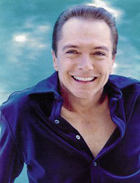
David Cassidy on the Web
To baldly go...... and take the fight to hair loss
June 12, 2011
By Anna Burnside
Scotland on Sunday
Wayne Rooney is the latest in a growing number of men determined to tackle their hair loss head on
WHEN you have World Cup ears, a neck like a rone pipe and a face that only a mother could love, does it matter that you are also losing your (bristly, nothing-coloured) hair? Wayne Rooney thinks so. He, his family and £30,000-worth of freshly transplanted follicles are currently holidaying in Barbados. Via Twitter, we are kept informed of their progress. "The new hair is coming on people" he tweeted on Thursday. "Swelling gone down #hairwego."
Rooney is far from the only man in the public eye to enlist professional help when his scalp starts marching through his once generous locks.
Earlier this year James Nesbitt said that his transplant had changed his life; a video of him discussing the operation even appears on the website of the Dublin clinic where he had the procedure. John Cleese, former Australian cricketer Shane Warne, Italian prime minister Silvio Berlusconi, former Rangers manager Dick Advocaat and Gordon Ramsay have had the op. The difference is that Rooney has been candid about it. "I was going bald at 25," he tweeted. "Why not?"
This could be seen as a clever way of pre-empting months of tiresome tabloid speculation and dressing room ragging. When you can't take your small son for a stroll in the park without an entourage of paparazzi following the pram, it makes sense to front it up.
On the other hand, it's quite possible that for Rooney, surrounded by men and women who spray themselves brown, swap their original nails and teeth for gleaming acrylic ones, surgically augment their upper bodies and hoover unwanted fat out of their lower ones, a hair transplant is the most obvious response to male pattern baldness. Even with the new thatch, he will still be one of the most natural-looking people he knows.
Greg Gordon, a betting industry football scout, thinks Rooney had the op for professional reasons. "There is no stigma with male pattern baldness now. Gay men have shown that keeping hair cropped in and in decent condition is a good look.The only areas where transplants have a constituency are sports, showbiz and business, where fear of being usurped by younger rivals, and incipient paranoia, runs rampant.
"Footballers' professional status is predicated on insecurity: fear of injuries, loss of form, their face not fitting with a new manager and most importantly, being replaced by a younger, fitter, faster model."
We are all guilty, says Gordon, of judging sports stars on appearance. "Look at Bobby Charlton with his comb-over and George Best with his flowing, raven locks. Charlton was the more effective player, both in his personal career and as a teammate. However, nobody is rushing to celebrate his maverick genius. It is the same with David Beckham and Paul Scholes. Charlton and Scholes are the superior players but neither will sell aspirational consumer products on the back of their image."
Rooney knows, says Gordon, that he is up against some of the world's hottest men, for advertising contracts as well as a place on the first team. "Rooney, a whey-faced, potato-head from a housing scheme, is directly competing with (Lionel] Messi and Cristiano Ronaldo and there is no question his reputation is diminished by his appearance in relation to those handsome, hirsute rivals."
Figures are thin on the ground but Dr Bessam Farjo, of the Institute of Trichologists, estimates that around 10,000 hair transplants are performed in the UK each year. This has doubled over the past five years.
It is a fiddly, expensive procedure. Rooney had follicular unit extraction, where hair is taken from the back of the head, separated into individual follicles and then transplanted onto the bare area at the front. A patient might need anything from 1,000 to 4,500 follicles moved.
It is done using a local anaesthetic and up to 18 staff - the surgeon, technicians, nurses - work together to get the precious follicles out of the back of the head and into the front as quickly as possible, before oxygen deprivation kills them off.
This does not come cheap. Hair Restoration Blackrock, the Dublin clinic that returfed James Nesbitt's shiny scalp, charges £7.60 per follicle. Estimates for Rooney's work range between £20,000 and £100,000.
When it works well, as in Nesbitt's case, it can look extremely natural and convincing. Fearful that his career was following his hair down the plughole, he had two procedures. Rethatched, he was then cast in the Emilio Estevez drama The Way, Ralph Fiennes' adaptation of Coriolanus and Peter Jackson's The Hobbit. "Several years ago I began losing my hair and like a lot of men it was a major concern to me. In fact, it was practically an obsession," he says on the clinic website. "But also I'm an actor and in the public eye a lot and I really felt that my hair loss could affect my career prospects. So, after many agonies and a great amount of thought - and believe me it's something I didn't take lightly - I took the decision to visit Hair Restoration.
"I am very pleased with the results. In fact, I would go as far as to say it has changed my life."
It's a sentiment with which journalist Brian Beacom, who had a hair transplant five years ago, has sympathy. Beacom, a feature writer at the Herald and Evening Times in Glasgow, wrote a book about his search for David Cassidy hair and sees no reason why men should be considered desperate, vain or shallow if they chose to rejuvenate their hairlines.
He is delighted Rooney has joined team transplant. "I think it's fantastic. People like Wayne Rooney are role models. Hair transplants have had such a bad name over the last 20 years, this is a real indication that the operation can be successful. It will help eradicate the Elton experience. The guy on the street will see Rooney and James Nesbitt and Dr Christian Jessen from Channel 4's Embarrassing Bodies, and it will become real for them."
Beacom adds, however, that many surgeons consider 25 too young for a transplant. "You can carry on losing your hair up to the age of 40 and beyond. Rooney's hair has been taken from the back of his head and moved to the front. If that hair is genetically programmed to fall out at 40, it will still do that."
These are, he says, the pitfalls of the procedure. "Clinics that are more aware and conscientious will not give hair transplants to people under 40. There are lots of clinics out there selling packages like double-glazing salesmen. Anyone can claim to be a transplant surgeon, there is no official accreditation and no exams."
Since having his own - successful - procedure, Beacom has compared notes with former EastEnders' actor Shaun Williamson. He has even met his hair idol, David Cassidy. To his delight, it turns out that Cassidy has now had two transplants himself. "When you have a hair transplant you feel far better in yourself," says Beacom. "You look ten years younger, you have confidence that you didn't even know you were losing. I went into Boots and bought a comb for the pocket of every single jacket I own. There is nothing sweeter than having a comb in your pocket and being able to use it."
